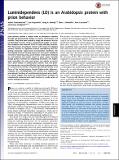| dc.contributor.author | Chakrabortee, Sohini | |
| dc.contributor.author | Kayatekin, Can | |
| dc.contributor.author | Mendillo, Marc L. | |
| dc.contributor.author | Lancaster, Alex | |
| dc.contributor.author | Newby, Gregory Arthur | |
| dc.contributor.author | Lindquist, Susan | |
| dc.date.accessioned | 2016-11-29T20:28:59Z | |
| dc.date.available | 2016-11-29T20:28:59Z | |
| dc.date.issued | 2016-04 | |
| dc.date.submitted | 2015-09 | |
| dc.identifier.issn | 0027-8424 | |
| dc.identifier.issn | 1091-6490 | |
| dc.identifier.uri | http://hdl.handle.net/1721.1/105465 | |
| dc.description.abstract | Prion proteins provide a unique mode of biochemical memory through self-perpetuating changes in protein conformation and function. They have been studied in fungi and mammals, but not yet identified in plants. Using a computational model, we identified candidate prion domains (PrDs) in nearly 500 plant proteins. Plant flowering is of particular interest with respect to biological memory, because its regulation involves remembering and integrating previously experienced environmental conditions. We investigated the prion-forming capacity of three prion candidates involved in flowering using a yeast model, where prion attributes are well defined and readily tested. In yeast, prions heritably change protein functions by templating monomers into higher-order assemblies. For most yeast prions, the capacity to convert into a prion resides in a distinct prion domain. Thus, new prion-forming domains can be identified by functional complementation of a known prion domain. The prion-like domains (PrDs) of all three of the tested proteins formed higher-order oligomers. Uniquely, the Luminidependens PrD (LDPrD) fully replaced the prion-domain functions of a well-characterized yeast prion, Sup35. Our results suggest that prion-like conformational switches are evolutionarily conserved and might function in a wide variety of normal biological processes. | en_US |
| dc.description.sponsorship | Howard Hughes Medical Institute | en_US |
| dc.description.sponsorship | G. Harold and Leila Y. Mathers Foundation | en_US |
| dc.description.sponsorship | Eleanor Schwartz Charitable Foundation | en_US |
| dc.description.sponsorship | National Science Foundation (U.S.). Graduate Research Fellowship Program | en_US |
| dc.language.iso | en_US | |
| dc.publisher | National Academy of Sciences (U.S.) | en_US |
| dc.relation.isversionof | http://dx.doi.org/10.1073/pnas.1604478113 | en_US |
| dc.rights | Article is made available in accordance with the publisher's policy and may be subject to US copyright law. Please refer to the publisher's site for terms of use. | en_US |
| dc.source | PNAS | en_US |
| dc.title | Luminidependens (LD) is an Arabidopsis protein with prion behavior | en_US |
| dc.type | Article | en_US |
| dc.identifier.citation | Chakrabortee, Sohini et al. “Luminidependens (LD) Is an Arabidopsis Protein with Prion Behavior.” Proceedings of the National Academy of Sciences 113.21 (2016): 6065–6070. © 2016 National Academy of Sciences | en_US |
| dc.contributor.department | Massachusetts Institute of Technology. Department of Biology | en_US |
| dc.contributor.department | Whitehead Institute for Biomedical Research | en_US |
| dc.contributor.mitauthor | Newby, Gregory Arthur | |
| dc.contributor.mitauthor | Lindquist, Susan | |
| dc.relation.journal | Proceedings of the National Academy of Sciences | en_US |
| dc.eprint.version | Final published version | en_US |
| dc.type.uri | http://purl.org/eprint/type/JournalArticle | en_US |
| eprint.status | http://purl.org/eprint/status/PeerReviewed | en_US |
| dspace.orderedauthors | Chakrabortee, Sohini; Kayatekin, Can; Newby, Greg A.; Mendillo, Marc L.; Lancaster, Alex; Lindquist, Susan | en_US |
| dspace.embargo.terms | N | en_US |
| dc.identifier.orcid | https://orcid.org/0000-0002-1999-0169 | |
| dc.identifier.orcid | https://orcid.org/0000-0003-1307-882X | |
| mit.license | PUBLISHER_POLICY | en_US |
